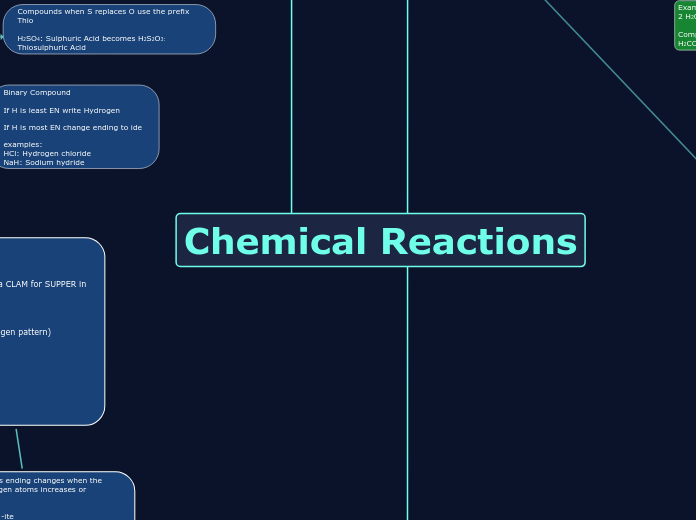Chemical Reactions
Types of Chemical Reactions
Synthesis Reaction
Two Elements or Compounds yield to make one compound.
A + B → AB
Examples
Ca(s) + O2( g) → 2CaO(s)
Involving compounds:
SO3(g) + H2O(l) → 2SO4(aq)
CaO (s) + H2O (l) → Ca(OH)2 (aq)
Decomposition Reaction
One compound breaks down into smaller compounds or elements
AB → A + B
Examples
2 H2O (l) → 2 H2 (g) + O2 (g)
Compounds:
H2CO3 → H2O + CO2
Combustion Reaction
When a fuel which is often hydrocarbon, reacts with oxygen producing oxides, water and sometimes solid carbon
Complete: When their is excess if oxygen available to react with the fuel
Produces only carbon dioxide and water vapor
▲
Example: CH4 (g) + 2O2 (g)→CO2 (g)+2 H2O (g)
Incomplete Combustion: When there is limited amount of oxygen available to react with fuel
produces multiple possible carbon products (parts of carbon dioxide and water.
▲
Example: 2 CH4 (g)+3 O2 (g)→2 CO (g)+4 H2O (g)
Subtopic
Single Displacement Reaction
One element in a compound is replaced by another element usually the metals replacing each other.
One element has to be higher on the activity series than the other to be able to displace it
A + BC → AC + B
Examples:
Fe (s)+CuSO4 (aq)→Cu(s)+FeSO4 (aq)
Cu (s)+ NaBr2 (aq)→no reaction
Cu is less Reactive than NA
Activity Series:
1. Magnesium
2. Zinc
3. Iron
4. Nickel
5. Tin
6. Lead
7. Hydrogen
8. Copper
9. Silver
Double Displacement:
This is the exchange of cations between two ionic compounds
Not all compound will be able to react it must be able to create a new substance
AB + CD → AD + CB
Examples:
BaCl2 (aq)+(NH4)2 SO4 (aq)→BaSO4 (s)+2NH4Cl (aq)
Insoluble
forms a ppt
FeCl3 (aq)+ Na2SO4 (aq) ⇾ No Reaction!
If it were to react both compounds are soluble therefore no new substance would be formed
Solubility Guidelines
1. Find cation
2. Find anion
3. Higher rank dictates RESULT
Neutralization
An acid and base react to form an ionic compound and water
Examples:
NaOH (aq) +HCl (aq)→NaCl (aq) +H2O (l)
Balancing Equations
Chemical Equation:
A short form to represent chemical reactions
Reactants → Products
MAke sure to state the state of the element at room temperature
In a balanced equation there has to be equal numbers of each kind of atom on both the left and right sides of the equation (Law of Conservation of Mass) which states that mass can not be created or destroyed but transferred
Example of balanced equations:
NaOH (aq) +HCl (aq)→NaCl (aq)+H2O (l)
BaCl2 (aq)+(NH4)2 SO4 (aq)→BaSO4 (s)+2NH4Cl (aq)
Nomenclature
Valence Oxidation Number
Rules:
1. Ionic bonds valence represents charges of ions when that are formed
2. Covalent bonds Valence represents how many electrons the atoms will contribute to to the bond (Sharing)
Naming Compounds
Covalent Compounds
Non-metal + Non-Metal
1. Use name of the first atom with prefix (except mono)
2. Add -ide to the stem of the second atom with prefix
Use Prefixes represents the number of atoms:
mono = 1
di = 2
tri =3
tetra = 4
penta = 5
hexa = 6
hepta = 7
octa = 8
examples:
dihydrogen monoxide = H₂O
nitrogen monoxide = NO
Ionic Compounds:
Metal + Non-Metal-ide
examples:
NaCl: Sodium Chloride
LiF: Lithium Fluoride
Multiple Valences:
Transition metals sometimes have more than one valance
ex. Fe+2 , Fe +3
Roman Numerals represent Valence:
I = 1
II = 2
III = 3
IV = 4
V = 5
VI = 6
Naming:
Metal (Valence # in roman numerals) + Non-metal-ide
Latin Prefix:
Latin prefix can be used to indicate the metal involved
Antimony=stib-
Chromium=chrom-
Copper=cupr-
Iron =ferr-
Lead=plumb-
Tin=stann-
Transition metal higher valance -ic
smaller valence -ous
examples:
FeCl₂ = Ferrous chloride
CuBr = Cuprous bromide
Binary Compound
If H is least EN write Hydrogen
If H is most EN change ending to ide
examples:
HCl: Hydrogen chloride
NaH: Sodium hydride
Oxy Acids
Polyatomic radicals bound to Hydrogen
change the ending -ate to -ic
example:
HClO3: Chloric acid
Oxy acids ending changes when the number of oxygen atoms increases or decreases
1 less oxygen: -ous
2 less oxygen: -hypo_ous
1 more oxygen: -per_ic
examples:
HClO4 (aq): perchloric acid
HClO (aq) : Hypochlorous acid
Acid Salt:
when H+ joins a polyatomic ion and reduces the charge by 1 each H+ added.
Add Hydrogen in front of the anion name(polyatomic)
examples
HCO3-: hydrogen carbonate
H2PO4-: dihydrogen phosphate
Potassium dihydrogen phosphite: KH2PO3
Additional Acids/ Radicals
Peroxides
Peroxides have one more oxygen than a normal oxide O2 -2
examples:
Na2O2: Sodium Peroxide
Compounds when S replaces O use the prefix Thio
H2SO4: Sulphuric Acid becomes H2S2O3: Thiosulphuric Acid
